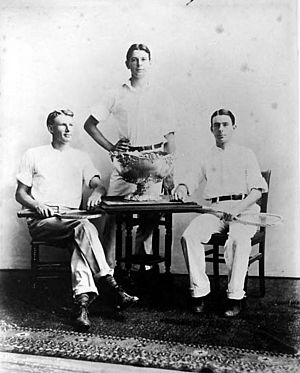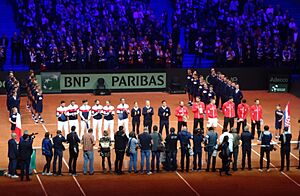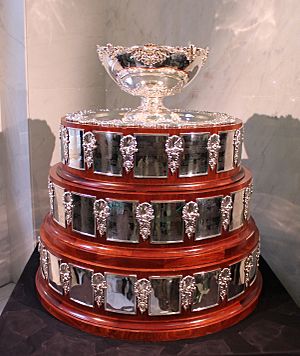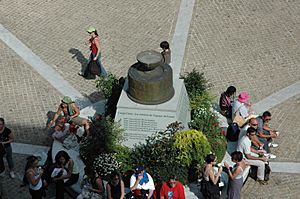Davis Cup facts for kids
| Sport | Tennis |
|---|---|
| Founded | 1900 |
| Founder | Dwight F. Davis |
| No. of teams | 155 (2025) |
| Countries | ITF member nations |
| Continent | Worldwide |
| Most recent champion(s) |
(3rd title) |
| Most titles | (32 titles) |
| Official website | daviscup.com |
The Davis Cup is the top international team competition for men's tennis. It is run by the International Tennis Federation (ITF) every year. Teams from over 150 countries play, making it the biggest yearly team sports event in the world. It's often called the "World Cup of Tennis," and the winning team is known as the world champion. The competition started in 1900 with a match between Great Britain and the United States. By 2023, 155 nations had entered teams.
The United States has won the most titles, with 32 wins and 29 runner-up finishes. The most recent champions are Italy. They beat the Netherlands in 2024 to win their third title, and their second in a row.
The women's version of the Davis Cup is the Billie Jean King Cup. It was once known as the Federation Cup (1963–1995) and Fed Cup (1995–2020). Only a few countries have won both the Davis Cup and the Billie Jean King Cup in the same year. These are Australia, Italy, Russia, the Czech Republic, and the United States.
Until 1973, only amateur players and national professional players (from 1968) could compete in the Davis Cup. This rule changed five years after the start of the Open Era, when professional players were allowed in major tennis events.
Contents
History of the Davis Cup
The idea for a tennis event between British and American players likely came from James Dwight. He was the first president of the U.S. Lawn Tennis Association in 1881. He wanted to see how American players compared to the famous British champions. He tried hard to set up an official match but couldn't.
However, by the mid-1890s, British and American players were visiting each other's countries to play tennis every year. This led to a friendship between American William Larned and Irishman Harold Mahony. They pushed for an official team competition between their nations.
Before the first Davis Cup match in 1900, other international competitions had already taken place. For example, England and Ireland had an annual team competition since 1892. This was similar to what the Davis Cup would become, with both single and doubles matches. In 1895, England also played against France in a team event.

Dwight F. Davis was a student at Harvard University and a tennis player. He was at a tournament in Canada where people discussed an international competition. His name was mentioned as someone who might "put up some big prize, or cup." Davis decided to donate a special trophy for the competition. He bought a sterling silver punchbowl trophy with his own money for about $1,000.
The first match was between the United States and Britain (called the "British Isles"). It took place at the Longwood Cricket Club in Boston, Massachusetts, in 1900. The American team, led by Dwight Davis, surprised everyone by winning the first three matches.
The competition was first called the International Lawn Tennis Challenge. But it soon became known as the Davis Cup, named after Dwight Davis's trophy. At first, teams played against each other to earn the right to challenge the previous year's champion in the final.
By 1905, the event grew to include teams from Belgium, Austria, France, and Australasia. Australasia was a combined team from Australia and New Zealand. They played together until 1914.
In 1923, teams were divided into two areas: the "America Zone" and the "Europe Zone." The winners of these zones then played each other to decide who would challenge the defending champion. In 1955, an "Eastern Zone" was added.
From 1950 to 1967, Australia was very strong. They won the Cup 15 times in 18 years.
Starting in 1972, the format changed to a knockout competition. This meant the defending champion had to play in all rounds, just like other teams. The Davis Cup was then given to the team that won the final knockout match.
Until 1973, only the United States, Great Britain/British Isles, France, and Australia/Australasia had won the Davis Cup. This changed in 1974. South Africa and India reached the final. However, India refused to travel to South Africa because of South Africa's apartheid policies. So, South Africa was awarded the cup. The next year saw the first final between two "outsider" nations. Sweden beat Czechoslovakia 3–2. Since then, many other countries have won the trophy.
In 1981, a new system was created. The 16 best national teams played in the World Group. All other teams played in regional zones. The teams that lost in the first round of the World Group played a special match. The winner stayed in the World Group, and the loser moved down to a regional zone. The winners of the regional zones could move up to the World Group the next year.
In 2018, the ITF voted to change the competition format starting in 2019. It became an 18-team event held at one location over one week at the end of the season. This new format, supported by famous footballer Gerard Piqué, was meant to make the event more exciting for sponsors and TV. Some players and countries liked the change, while others did not. On January 12, 2023, the ITF announced that it would take back control of the event.
Davis Cup matches have sometimes been affected by political protests. For example, in 1968, a match between Sweden and Rhodesia was moved due to protests against Rhodesia's white minority government. In 1975, the Swedish government tried to stop a match between Chile and Sweden because of human rights concerns in Chile. The match was played, but 7,000 people protested outside. In 2009, 6,000 people protested outside a match between Sweden and Israel in Malmö, Sweden. This was due to the conflict between Israel and Gaza.
Russia and Belarus were suspended from the competition after the 2022 Russian invasion of Ukraine.
The Davis Cup Trophy
The Davis Cup trophy is a very impressive piece of silver. It was originally made for £700. It weighs 217 ounces (about 6.15 kg) and stands 13 inches (about 33 cm) tall. It has a diameter of 18 inches (about 46 cm) and sits on three bases.
Today, the Davis Cup Trophy is cared for and repaired by famous goldsmiths and silversmiths, Thomas Lyte.
How the Davis Cup Works
Competition Format
The 18 best national teams play in the World Group each year to win the Davis Cup. Nations not in the World Group compete in one of three regional zones: Americas, Asia/Oceania, and Europe/Africa. The competition takes place over four weekends throughout the year. Each round between two countries is held in one of those countries. It involves five matches: four singles matches and one doubles match. The ITF decides which country hosts each match-up before the tournament starts.
The World Group is the top level, with the 18 best national teams. Teams in the World Group play in a four-round knockout event. Teams are ranked based on their past results. The defending champion and the runner-up are always the top two ranked teams. Teams that lose in the first round go to a playoff round. There, they play against winners from Group I of the regional zones. The winners of these playoff matches stay in the World Group for the next year. The losers move down to Group I of their regional zone.
Each of the three regional zones has four groups. Groups I and II play knockout rounds. Losing teams can be moved down to a lower group. Teams in Groups III and IV play a round-robin event. This means every team plays against every other team in their group. Teams can be moved up or down based on their results.
Changes in 2019
For the 2019 competition, the format of the cup changed. The biggest change was that the World Group event now happens in one place and over one week. Eighteen teams are divided into six groups of three teams each. The winners of these groups and the two best second-place teams move on to the quarterfinals. In this stage, each match-up between teams has two singles matches and one doubles match. These matches are played as the best of three sets, instead of the previous best of five sets. Since the World Group now takes place as one big event, it is called the Davis Cup Finals. The lower zone groups (I and II) now have single matches to decide who moves up or down.
Structure of the Competition
| Level | Group(s) | |||
|---|---|---|---|---|
| 1 | World Group 18 countries |
|||
| 2 | Group One Americas Zone 6 countries |
Group One Europe/Africa Zone 11 countries |
Group One Asia/Oceania Zone 7 countries |
|
| 3 | Group Two Americas Zone 8 countries |
Group Two Europe/Africa Zone 16 countries |
Group Two Asia/Oceania Zone 8 countries |
|
| 4 | Group Three Americas Zone 9 countries |
Group Three Europe Zone 15 countries |
Group Three Africa Zone 10 countries |
Group Three Asia/Oceania Zone 9 countries |
| 5 | Group Four Asia/Oceania Zone 11 countries |
|||
Note: The total number of nations in Group One is 24. However, the number of countries in each zone can change yearly. This depends on how many nations move up or down between Group One and the World Group. The World Group and Group One together have 22 nations from the Euro/Africa Zone, 9 from the Americas Zone, and 9 from the Asia/Oceania Zone.
Matches and Rubbers
In the Davis Cup, a tie means an elimination round between two countries. A rubber means an individual match within that tie.
In the yearly World Group competition, 16 nations play in eight first-round ties. The eight winners play in four quarterfinal ties. The four winners play in two semifinal ties. Finally, the two winners play in the final tie.
Each tie has five rubbers, played over three days (usually Friday, Saturday, and Sunday). The country that wins three or more of the five rubbers wins the tie. On the first day, the first two rubbers are singles matches. These are usually played by each nation's two best singles players. On the second day, the doubles rubber is played. On the third day, the last two rubbers are usually reverse singles. In these, the players from the first day's singles matches play again, but they switch opponents. However, a team captain can sometimes replace players. For example, if a team has already won the tie, younger players might play the remaining dead rubbers to gain experience.
Since 2011, if a nation has a winning 3–1 lead after the first reverse singles match, and that match went to four sets or more, the last reverse singles match (a dead rubber) is not played. All five rubbers are played if one nation has a winning 3–0 lead after the doubles match.
Ties are played at a location chosen by one of the competing countries. The right to choose alternates between countries. If two countries haven't played each other since 1970, a draw decides the host country.
Venues for World Group matches must meet certain minimum seating requirements:
- World Group play-offs: 4,000 seats
- World Group first round: 4,000 seats
- World Group quarterfinals: 6,000 seats
- World Group semifinals: 8,000 seats
- World Group final: 12,000 seats
Team Captain
Before each tie, the captain (a coach chosen by the national tennis group) picks four players for the team. They also decide who will play in each match. The day before play starts, the order of play for the first day is chosen randomly. In the past, teams could only change players for the final day if someone was injured or sick. But now, the captain can choose any player for the last two singles matches, as long as the first day's matchups are not repeated. There are no rules about who can play the doubles match. It can be the two singles players, two other players (often doubles experts), or a mix.
Each rubber is usually played as the best of five sets. Since 2016, all sets use a tiebreak at 6–6 if needed. Before 2016, the fifth set usually didn't have a tiebreaker, so play continued until one side won by two games (like 10–8). However, if a team has already won the tie before all five rubbers are finished, the remaining matches might be shortened to the best of three sets, with a tiebreak if needed.
In Group III and Group IV competitions, each tie has only three rubbers. These include two singles and one doubles match, played on a single day. These rubbers are played as the best of three sets, with a tiebreaker if needed for all three sets.
Records and Statistics
Team Performance
| Country | Winners | Runners-up |
|---|---|---|
| 1900, 1902, 1913, 1920, 1921, 1922, 1923, 1924, 1925, 1926, 1937, 1938, 1946, 1947, 1948, 1949, 1954, 1958, 1963, 1968, 1969, 1970, 1971, 1972, 1978, 1979, 1981, 1982, 1990, 1992, 1995, 2007 (32) | 1903, 1905, 1906, 1908, 1909, 1911, 1914, 1927, 1928, 1929, 1930, 1932, 1934, 1935, 1939, 1950, 1951, 1952, 1953, 1955, 1956, 1957, 1959, 1964, 1973, 1984, 1991, 1997, 2004 (29) | |
| 1907, 1908, 1909, 1911, 1914, 1919, 1939, 1950, 1951, 1952, 1953, 1955, 1956, 1957, 1959, 1960, 1961, 1962, 1964, 1965, 1966, 1967, 1973, 1977, 1983, 1986, 1999, 2003 (28) | 1912, 1920, 1922, 1923, 1924, 1936, 1938, 1946, 1947, 1948, 1949, 1954, 1958, 1963, 1968, 1990, 1993, 2000, 2001, 2022, 2023 (21) | |
| 1927, 1928, 1929, 1930, 1931, 1932, 1991, 1996, 2001, 2017 (10) | 1925, 1926, 1933, 1982, 1999, 2002, 2010, 2014, 2018 (9) | |
| 1903, 1994, 1905, 1906, 1912, 1933, 1934, 1935, 1936, 2015 (10) | 1900, 1902, 1907, 1913, 1919, 1931, 1937, 1978 (8) | |
| 1975, 1984, 1985, 1987, 1994, 1997, 1998 (7) | 1983, 1986, 1988, 1989, 1996 (5) | |
| 2000, 2004, 2008, 2009, 2011, 2019 (6) | 1965, 1967, 2003, 2012 (4) | |
| 1976, 2023, 2024 (3) | 1960, 1961, 1977, 1979, 1980, 1998 (6) | |
| 2002, 2006, 2021 (3) | 1994, 1995, 2007 (3) | |
| 1988, 1989, 1993 (3) | 1970, 1985 (2) | |
| 1980, 2012, 2013 (3) | 1975, 2009 (2) | |
| 2005, 2018 (2) | 2016, 2020–21 (2) | |
| 2016 (1) | 1981, 2006, 2008, 2011 (4) | |
| 2010 (1) | 2013 (1) | |
| 2014 (1) | 1992 (1) | |
| 2022 (1) | 2019 (1) | |
| 1974 (1) | — | |
| — | 1969, 1971, 1972 (3) | |
| — | 1966, 1974, 1987 (3) | |
| — | 1904, 2015, 2017 (3) | |
| — | 1921 (1) | |
| — | 1962 (1) | |
| — | 1976 (1) | |
| — | 2005 (1) | |
| — | 2024 (1) |
Titles by Country (Since 1972)
| Country | Titles | First | Last |
|---|---|---|---|
| 9 | 1972 | 2007 | |
| 7 | 1975 | 1998 | |
| 6 | 1973 | 2003 | |
| 6 | 2000 | 2019 | |
| 4 | 1991 | 2017 | |
| 3 | 1976 | 2024 | |
| 3 | 1980 | 2013 | |
| 3 | 1988 | 1993 | |
| 3 | 2002 | 2021 | |
| 2 | 2005 | 2018 | |
| 1 | 1974 | ||
| 1 | 2010 | ||
| 1 | 2014 | ||
| 1 | 2015 | ||
| 1 | 2016 | ||
| 1 | 2022 | ||
- Most Consecutive Titles:
- Most Consecutive Finals Appearances:
- All-time: 23, Australia, from 1946 to 1968.
- Since 1972: 7, Sweden, from 1983 to 1989.
Years in World Group
- United States 37
- Czech Republic 36
- France 36
- Germany 35
- Spain 32
- Australia 31
- Sweden 31
- Italy 27
- Switzerland 27
- Russia 26
- Argentina 25
- Belgium 20
- Serbia 20
- Netherlands 19
- Austria 17
- Great Britain 17
- Croatia 16
- Romania 14
- Brazil 13
- India 13
- Canada 10
- Israel 10
- Mexico 10
- Chile 9
- Denmark 9
- Japan 8
- New Zealand 8
- Kazakhstan 7
- Paraguay 7
- Slovakia 7
- South Korea 5
- Ecuador 5
- Belarus 4
- South Africa 4
- Hungary 3
- Morocco 3
- Zimbabwe 3
- Indonesia 2
- Cuba 1
- Ireland 1
- Peru 1
- Poland 1
Most Wins in World Group
| Country | # | |
|---|---|---|
| 1. | 64 | |
| 2. | 58 | |
| 3. | 56 | |
| 4. | 50 | |
| 5. | 40 | |
| 6. | 39 | |
| 7. | 37 | |
| 8. | 33 | |
| 9. | 28 | |
| 10. | 22 |
Individual Records
- Most titles as a player:
- Roy Emerson from Australia won 8 titles.
- Most titles as captain:
- Harry Hopman from Australia led his team to 16 titles.
- Youngest player:
- Marco De Rossi from San Marino played at 13 years, 319 days old (on May 12, 2011).
- Oldest player:
- Vittorio Pellandra from San Marino played at 66 years, 104 days old (on May 11, 2007).
- Most years played:
- Leander Paes from India played for 30 years (1990–2010, 2012–2020).
- Most ties played:
- Omar Al-Awadhi from United Arab Emirates played in 102 ties (1996–2024).
- Most rubbers played:
- Nicola Pietrangeli from Italy played 164 rubbers (1954–1972).
- Most rubbers won:
- Total: 120, Nicola Pietrangeli, Italy.
- Singles: 78, Nicola Pietrangeli, Italy.
- Doubles: 45, Leander Paes, India.
Current ITF Davis Cup Ranking
For more information, see ITF rankings
| ITF Davis Cup Nations Ranking, as of 3 February 2025[update] |
|||
|---|---|---|---|
| Rank | Nation | Points | Move† |
| 1 | 573.25 | ||
| 2 | 470.75 | ||
| 3 | 432.00 | ||
| 4 | 421.00 | ||
| 5 | 419.50 | ||
| 6 | 408.25 | ||
| 7 | 386.75 | ||
| 8 | 381.50 | ||
| 9 | 376.00 | ||
| 10 | 374.00 | ||
| 11 | 368.50 | ||
| 12 | 360.75 | ||
| 13 | 355.50 | ||
| 14 | 354.50 | ||
| 15 | 354.25 | ||
| 16 | 349.50 | ||
| 17 | 340.75 | ||
| 18 | 339.75 | ||
| 19 | 337.25 | ||
| 20 | 334.25 | ||
†Change since previous ranking update
See also
 In Spanish: Copa Davis para niños
In Spanish: Copa Davis para niños
- Junior Davis Cup and Junior Billie Jean King Cup
- List of Davis Cup champions
- Billie Jean King Cup
- ATP Cup
- Hopman Cup
- Davis Cup Tennis, a video game based on the event
- Other structural idea options for the Davis Cup
- History of tennis





